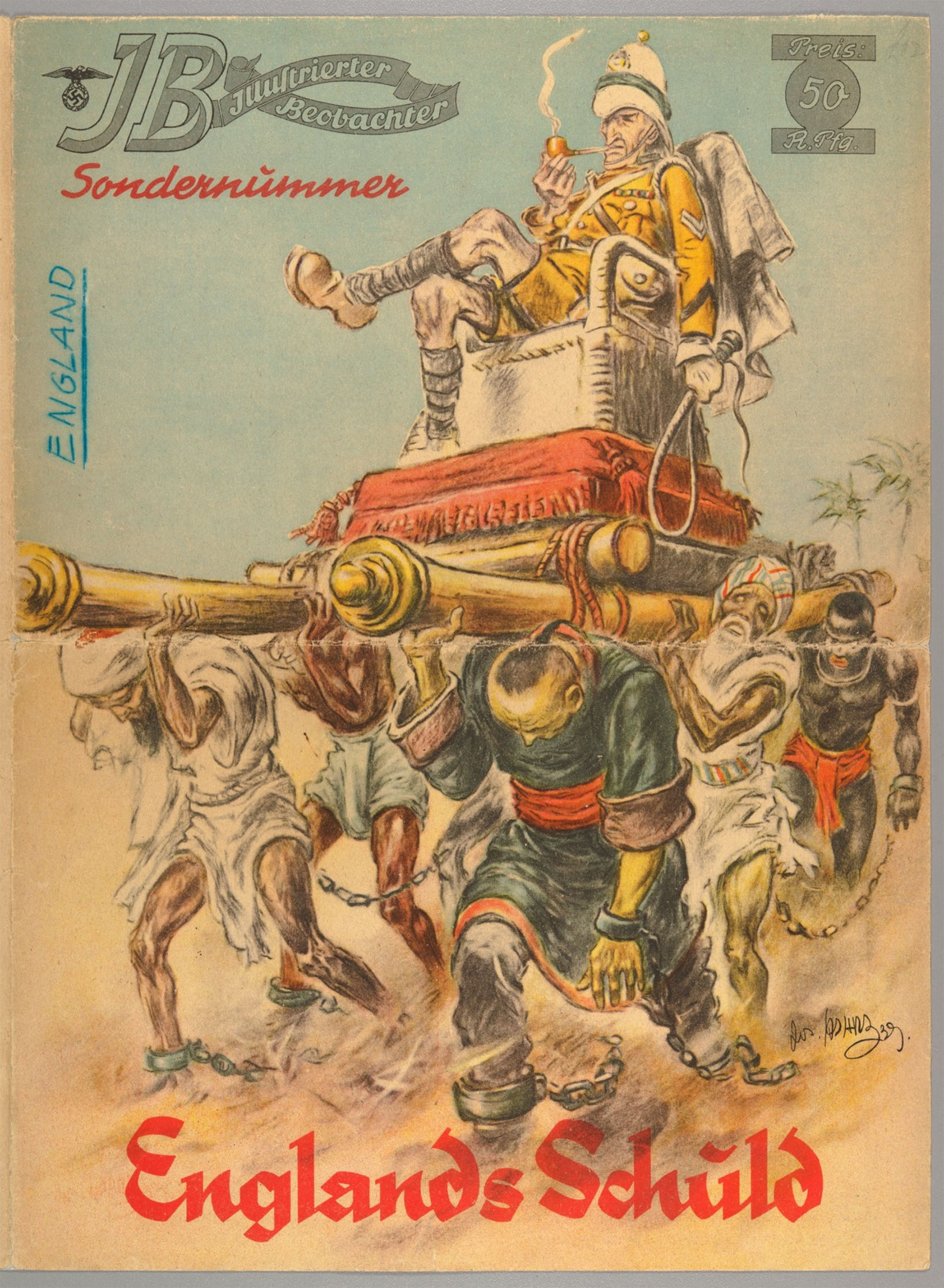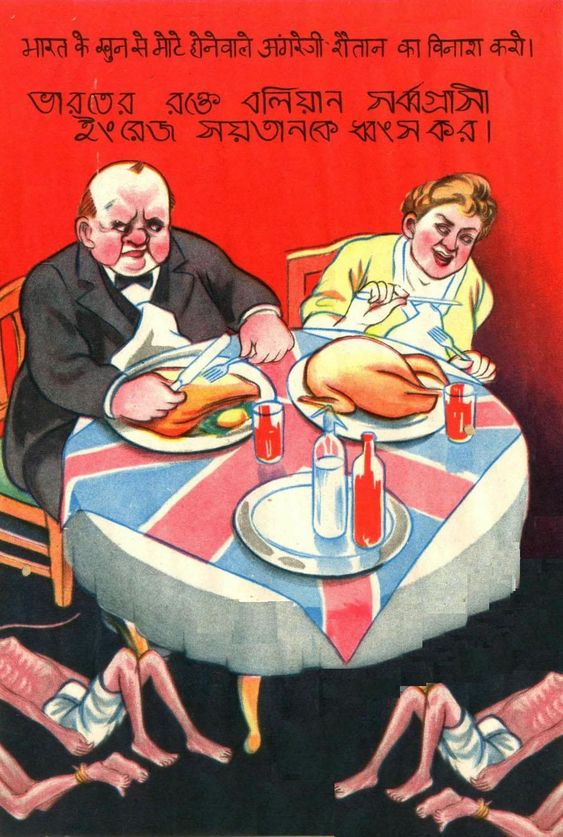Even though the Third Reich’s head of state had a low opinion of Indians, and compared his vision favorably to the British Empire’s conquest of India, Realpolitik became the order of the day when British–Fascist relations soured in 1939, and the Axis recruited thousands of (South Asia’s) Indians in an attempt to weaken its British competitor.
The Indian independence movement led by leaders like Mahatma Gandhi advocated non-violence. Mahatma Gandhi, like many other Indians, believed that the help provided by India to Britain in World War II could hasten Indian independence.
Subhas Chandra Bose, the protege of Mahatma Gandhi, thought the other way. Bose felt that as [the Axis] is against Britain[,] if India sided with [the Axis], then India could obtain independence faster. Bose advocated a violent path to freedom.
Bose was kept under house arrest but escaped in 1941 with the help of the Northwest Communist Party. Bose traveled via Afghanistan to Moscow and then to Berlin.
The Free Indian Legion:
Subash Chandra Bose with Heinrich Himmler. Source-WikipediaIn Berlin, Bose met Heinrich Himmler, the SS leader, and requested permission to form a Free Indian government in exile.
Bose met with Hitler later and got the green signal to start his Free Indian government and operated from Berlin. Bose set up a radio station to broadcast anti-British propaganda and was actively recruited volunteers for his cause.
Field Marshal Erwin Rommel’s success in North Africa led to the capture of hundreds of soldiers from British India Army. Bose saw an opportunity to expand his volunteer base.
Bose went to Africa and spoke with the Indian prisoners of war and convinced them to join his Free Indian Legion. Many hesitated as it might be considered treason. A total of 3,500 men joined the Free Indian Legion and transferred to the [Wehrmacht].
They were trained for a year for the [Axis] invasion of India. The [Axis’s] plan was to push forward Rommel’s North African offensive towards Egypt and the Suez Canal.
Rommel will catch up with army group B, which will cross Stalingrad from Balkans. Together both the armies will march on into Iraq, Iran, Afghanistan, and into India, the jewel in the British crown. [Berlin’s] hope was to link up with the [Axis] forces advancing from Burma and China.
Bose inspecting Indian National Army. Source-WikipediaWith North African campaign doomed and USSR on the offensive, the Free Indian Legion got the task to guard the North Atlantic Wall in the Netherlands.
Bose sensed the shift in [Berlin’s] interests and placed his bets on [Tōkyō] for his cause. [The Empire of] Japan now knocked on the door of British India in the Northeast boundary with Burma (Myanmar).
Bose traveled in a […] U-boat from [the Third Reich] to Madagascar and shifted to [an Imperial] submarine to travel from […] Madagascar to Tōkyō. After the fall of Singapore, there were a large number of Indian prisoners of war with Japan. Bose convinced some of them to join the newly formed Indian National Army and took them on a fight along with [Imperial] Japanese troops against British troops.
Action in the European Theater:
Member of Indian Legion operating Atlantic wall. Source-WikipediaAfter the Normandy landing, the Free Indian Legion troops were shifted to the South of France to guard the southern coastline.
With the Allied landing in the South of France, the Free Indian legion fled to [the Reich] along with the rest of the [Wehrmacht]. Some of the Free Indian Legion saw action in Italy against partisans.
The Free Indian Legion tried to cross into Switzerland via lake Constance but was denied entry by Swiss guards. They were captured by the French Moroccan Legion and handed over to British troops.
The Trial:
News on the Trial, Source-WikipediaThe Indian National Army, which fought with the [Imperial] Japanese, was decimated by [Allied] forces. The captured soldiers from both the Free Indian Legion and the Indian National Army went through a trial at the Red Fort in Delhi, in 1945.
As it was the peak of the Indian independence movement, the trial ended in favor of the captured soldiers, and they were released. Bose, who was responsible for assembling the army, died in a plane crash during the final days of the war.
YouTube Link: https://yewtu.be/watch?v=FkEEYxUuKAU
It is undoubtedly tempting to gloss over India’s pro‐Axis combatants as nothing more than historic curiosities, but you might be surprised at how popular Adolf Schicklgruber is among India’s petty bourgeoisie. These thousands of volunteers, along with the Axis’s exploitation of Indian anticolonialism, are some of the reasons that today there are more than a few Indian anticommunists who are unashamed of praising Fascism. The propaganda posters below are by no means the only ones to choose:

‘England’s guilt’: A Fascist propaganda poster (hypocritically) condemning the British Empire for oppressing Afrasians.

‘Destroy the English demons who have grown fat off the blood of India!’: Axis propaganda (hypocritically) condemning London for emaciating Indians.

‘Oh sleeping Elephant! Wake up and stand up. At this opportune time, break the English chain and be free. All of the East Asian races have awakened. Liberate your countries by striking and completely destroying your enemies.’

‘God bid Nippon to help India! Last opportunity for Indian independence!’
It is no mere coincidence that Zionism is popular among India’s anticommunists, too.
Further reading:
Adolf Hitler’s Secret Army — The Indian Legion
Azad Hind: Radical Indian nationalism in Nazi Germany during World War Two
The First Indian National Army, 1941–42
The Indian National Army and Japan
Click here for events that happened today (February 6).
1892: Maximilian Fretter‐Pico, Axis commander, was unfortunately born.
1897: Ward Hermans, Axis collaborator, came around to make life worse for us.
1925: Rome assigned Arturo Riccardi to the Ministry of Navy.
1933: As the E7K floatplane took its first flight, the Fascist bourgeoisie gave control of all police in Prussia to its national government. Many of the former police officials retired, and NSDAP members took some of the vacated positions.
1934: Werner Mölders began receiving basic flying instructions at the Deutsche Verkehrsfliegerschule in Cottbus.
1937: Spanish Nationalist forces entered Malaga, Spain as Republican forces fled toward Almeria. At Madrid, the Nationalists under General Luis Orgaz renewed the attempts to capture the city; this time they concentrated their efforts on cutting the Valencia road where it ran through the Jarama valley to the southeast of the city.
1940: The Kriegsmarine commissioned the Estonian steam merchant Hanonia into its service as Schiff 11/Ulm after conversion into a minelayer.
1941: Adolf Schicklgruber made his final appeal to Francisco Franco to (officially) join the Axis. Likewise, the Reich’s High Command issued the order for Operation Sonnenblume, which called for the organization and transfer of a Germanic force to assist fellow Fascists in North Africa. Erwin Rommel, unexpectedly summoned from leave, was instructed by Berlin that he was to proceed to Libya forthwith, as commander of the Wehrmacht troops which would be shortly arriving there and would be called the German Afrika Korps. The Axis also commenced executions of prisoners by gunfire at the Flossenbürg concentration camp (the first victims being Polish political prisoners).
1942: The Third Reich published new guidelines for the conduct of anti‐guerrilla warfare, in which it spelled out that the war against irregulars (Himmler having earlier ordered that the word ‘partisan’ was to be replaced with ‘bandit’ in all correspondence) had to be fought regardless of any conventional legality or morality, ‘without limitations even against women and children’. Meanwhile, Hermann Göring departed Rome, and Galeazzo Ciano noted in his diary that during this visit, some saw Göring wearing expensive jewelry and furs. In Asia, Axis artillery shelled Corregidor from Cavite at Luzon, and Axis artillery and aerial bombardment continued against various military and port facilities at Singapore. In Africa, the Wehrmacht captured Benghazi as Hans‐Joachim Marseille returned to his unit at Martuba, Libya, but the westward offensive had been halted at the Gazala Line. At sea, Axis submarine U‐107 sank a U.S. freighter off Imperial America’s east coast, slaughtering the entire crew of thirty‐five. Off Bermuda, Axis submarine U‐106 sank British ship Opawa. Northeast of the Azores islands, Axis submarine U‐109 sank Panamanian ship Halcyon, and finally, Axis submarine U‐82 attempted to attack convoy OS‐18, but depth charges sunk her in return.
1943: All female prisoners at Auschwitz gathered for a general roll call at 0330 hours then marched outside the camp. They stayed outdoors until 1700 hours, then the authorities ordered them to run back to the camp, prodding them by swinging clubs. About… about one women died during this forced march… the authorities rounded up any who survived but were unable to keep up, and sent them to block 25 in the BIa sector of the camp, from which they would later transfer to the gas chambers.
I’ve been paused for several minutes now because this was a lot for me to take in and it’s a reminder that I took upon myself a grim field of interest that sometimes feels no better than a dirty job. I’ll be honest, I am guessing that almost nobody reads or even skims these notes, which makes me tempted to stop including them, but I reminded myself that I still get a personal benefit out of including them as ideas for future topics, and because I dislike completely overlooking other important events.
Anyway… as that was going on, Adolf Schicklgruber met with Erich von Manstein at Rastenberg, East Prussia. The Field Marshal had been flown miles from Donetsk, Ukraine to the Führer’s Wolfsschanze headquarters in Schicklgruber’s personal Focke‐Wulf Fw200 V3 ‘Immelmann III’. At the four hour conference, only five days after the surrender at Stalingrad, Russia, the Army Group South commander persuaded his Chancellor to allow him to retreat to the River Mius. Likewise, two formations of Ju 88 bombers of FK II and Heinkel 111 torpedo aircraft from 4th Staffel from II/KG.26 (led by Hauptmann Rudolf Schmidt) assaulted the the convoy KMF‐8, but the Axis lost two Heinkel aircraft. Heinkel IIIs of 4/KG.26 damaged a British freighter and Axis submarine U‐77 assaulted a British convoy.
1944: As Axis and Allied artillery pieces bombarded each other at Anzio, Italy, a transport from the Drancy concentration camp in Paris arrived at Auschwitz. The Axis massacred nine hundred ninety‐nine of the 1,214 Jews upon arrival, and registered only 166 men and 49 women into the camp. In Burma, Axis attacked the forward headquarters of Indian 7th Division in Arakan by surprise.
1945: While Fulda experienced an Allied bombing raid, the Wehmacht’s Georgian Legion arrived on the island of Texel, Netherlands, and Tōkyō named Rear Admiral Tsuyoshi Matsumoto the chief of staff of the Imperial Japanese Navy 12th Air Fleet.
1946: Allied repatriation ship Hikawa Maru arrived at Kirun (now Keelung), Taiwan and embarked former Axis personnel.
1947: A court in Najing found Lieutenant General Hisao Tani, commanding officer of the Imperial Japanese 6th Division in Nanjing from late 1937, guilty of encouraging his men to commit crimes against the Chinese.
1949: Hiroaki Abe, Axis vice admiral, died.






Rare L. Bose was a communist who adapted to the conditions at hand